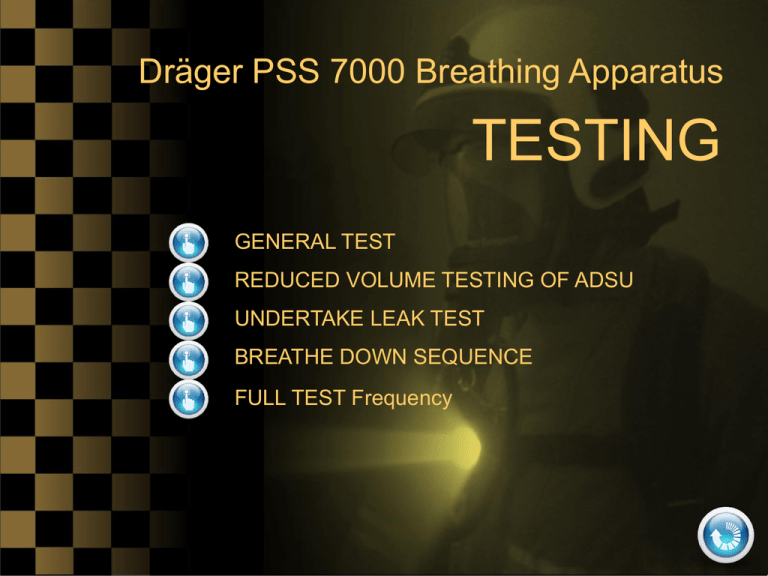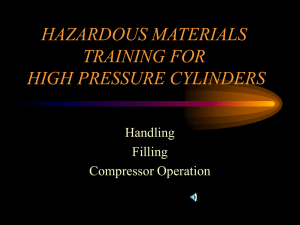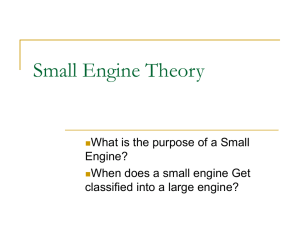TR003BA Training Package - Drager PSS 7000 BA Set Testing
advertisement

Dräger PSS 7000 Breathing Apparatus TESTING GENERAL TEST REDUCED VOLUME TESTING OF ADSU UNDERTAKE LEAK TEST BREATHE DOWN SEQUENCE FULL TEST Frequency Dräger PSS 7000 Breathing Apparatus – General ( T.O.R.) Test Memoire A ‘General test’ is to be carried out on a BA set: (a) When taking over a set. (b) Following a cylinder change. (c) When nominated to test a “spare” set. (d) Part time/Retained crews once a week 1 - Remove BA set from retaining bracket, charging connector will automatically disconnect 2 - CHECK that identification numbers located on the lung demand valve (LDV) , facemask, tally, front and rear of back plate match and are legible. 3 - CHECK the condition of cylinder cover and the cover markings and that it is fitted correctly. 4 - CHECK cylinder information as required by FRS (hydraulic test date and asset code/imprinted cylinder number). 5 - CHECK cylinder connection is hand-tight. Note: Finger and thumb pressure only. CHECK security of cylinder attachment. 6 - CHECK and adjust back plate to preferred position if required. 7 - CHECK the second person connection, all hose clips are secure and the hose is held in the clips. 8CHECK operation of BA set retaining bracket. Connect lead Ensure that the BA set is being charged (indicated by green LED on rechargeable battery pack and Bodyguard displaying “Battery Charging “icon). 9 - INSPECT the condition of shoulder straps, waist belt (ensuring they are fully extended), fastening buckle, Connection, BA personal line Retractable: Extending fully and checking the knot (1.2m). The knot should be checked to confirm that the full length of the personal line cannot be withdrawn without pressing the release button. Traditional: Remove the 1.2 line and check the Tenex clip is functioning correctly. Remove the rest of the line and check that the line is secured to the BA set appropriately. 10 - CHECK the LDV connection (gently push, twist and pull). 11 - CHECK the facemask, fittings, exhalation valve cover is not damaged or blocked and that the cover securing screw is in place. Fit aids to vision if required. Check Voice enhancement and batteries have no less than 25% life. 12 - OPERATE the first breath (Green)button on top of the LDV, RELEASE the first breath mechanism by operation of the additional flow button on the front of the LDV, a click should be heard, this confirms the mechanism has operated, REPEAT this test. REDUCED VOLUME and TEST of ADSU 13 - PRESS the Bodyguard LEFT button to start the ‘Self Check’ sequence. 14 - When the ‘Reduced Volume’ icon appears PRESS the LEFT button followed by the RIGHT button to confirm this setting. Note: ‘Reduced Volume’ is now set and will remain until the Bodyguard is reset. 15 - OPERATE first breath button. 16 - PUT the neck loop on, CONNECT facemask to retaining stud and CHECK it holds securely 17 - REMOVE Bodyguard key. REDUCED VOLUME and TEST of ADSU 18 - OPEN THE CYLINDER VALVE SLOWLY AND FULLY. The cylinder pressure must be sufficient to provide a minimum of 245 bar or above on completion of BA set testing. NOTE the pressure reading for entry into the BA log book. 19 - Test torch for 1 min and test ADSU, to test Pre-Alarm signal, CONFIRM the green LED continuously flashes – Wait 30 seconds – Pre- Alarm sounds – Cancel Pre-Alarm (tap side of unit) – Wait 30 seconds – Pre-Alarm sounds – Do not cancel – Wait 15 seconds Full alarm sounds – Check LED’s, two blue, two red and one green illuminate alternatively– INSERT Bodyguard key to cancel. REDUCED VOLUME and TEST of ADSU 20 - TEST the Manual DSU by PRESSING the yellow button in the centre of the unit to start the Manual DSU Alarm – Check LEDs, two blue and two red illuminate alternatively REMOVE and RE-INSERT Bodyguard key to cancel. UNDERTAKE LEAK TEST 21 PRESS and HOLD the Bodyguard LEFT button until the ‘Return Arrow’ icon appears. Then release to restart the ‘Self Check’ Sequence 22 The ‘Open Cylinder’ icon momentarily appears before the display changes to ‘Close Cylinder’ and ‘Press Right’ button alternating icons are displayed. CLOSE the cylinder valve and then PRESS the RIGHT button to confirm. UNDERTAKE LEAK TEST 23 - WAIT – Stabilisation taking place. 24 ‘Leak Test Timing’ icon appears for approximately 1 minute. Bar segments progressively switch off clockwise. Note: During the leak test a pressure drop of up to 10 bar is acceptable. 25 On completion, the ‘Leak Test Pass’ icon is displayed. Note: The ‘Breathe Down’ sequence should be completed within 3 minutes. The timing out of Bodyguard would necessitate the test being repeated. UNDERTAKE LEAK TEST 26 If the: ‘Leak Test Fail’ icon appears, ‘purge’ remaining air by operating additional flow button, check cylinder connection and LDV connection to facemask. Undertake second leak test - If test fails again return set as defective. BREATHE DOWN SEQUENCE 27 - OPEN THE CYLINDER VALVE SLOWLY AND FULLY 28 - DISCONNECT neck loop retaining stud and DON facemask, adjust straps (lower two first, then middle two and top one if required) and BREATHE normally. 29 - Check First breath function 30 - Listen for leaks whilst moving head from side to side 31 - Check for positive pressure (Insert two fingers into face mask seal by ear) 32 - CLOSE the cylinder valve, CONTINUE to hold onto the valve. BREATHE DOWN SEQUENCE 33 - Breathe down the set ensuring: The Electronic Low Pressure Warning Device and the red and blue LED’s flashing, (operates at 74 bar).and The Pneumatic Low Pressure Warning Whistle (operates at 60 bar +/- 5 bar). Note: Both devices must be heard to actuate. 34 - Continue to BREATHE steadily until the air is exhausted (0 bar displayed) and the facemask collapses and remains firmly sucked onto the face. 35 - Note ; If there is a defect with the facemask or a poor fit between the face and the mask, the wearer will be unable to generate a vacuum inside the mask thereby preventing the continued collapse on the face. If after adhering to the above guidance a gross face-seal leakage remains, the wearer should inform their Station Manager/OIC of station/establishment, who should in turn, contact the FRS Manager responsible for BA. Arrangements will then be made for a ‘formal’ face fit evaluation. BREATHE DOWN SEQUENCE 36 - BREATHE OUT SLIGHTLY to break the seal, and remove the facemask. CHECK the operation of radio interface equipment if fitted. 37 - Extend straps, wipe the facemask seal and inner mask with a specialist cloth only - NOT THE VISOR (where an anti-mist coating is present). CHECK and ensure the two inner mask non-return valves are in place and are seated correctly, RE-STOW the facemask into its bag. Note: Do not attach neck loop retaining stud. 38 - FILL OUT the BA tally. Ensure that printed details on the BA tally are clear and enter role and name. 39 - COMPLETE the BA log book. BREATHE DOWN SEQUENCE 40 - PLACE BA tally into ECB and ensure signal is achieved (green and blue LED’s illuminated on Bodyguard and ‘Green telemetry signal radio’ icon displayed on ECB). 41- REPLACE Bodyguard key, CHECK that the Bodyguard returns to the ‘Battery Charging’ icon. 42 - CHECK if available, that the spare cylinder is correctly stowed and is within the hydraulic test date. 43 - DISCONNECT the facemask from the Lung Demand Valve (LDV), clean and inspect and allow to dry. CHECK the exhalation valve cover securing screw is in place and that the cover is not damaged or blocked. CHECK LDV/filter port for damage. Only remove the inner mask if necessary and ensure the two non-return valves are in place and are seated correctly. 44 - Ensure 0 bar is displayed on Bodyguard. RELEASE the cylinder retaining strap mechanism and loosen the strap from the cylinder body. UNSCREW the cylinder connection to the reducer. 45 - REMOVE the cylinder in the opposite direction to the cylinder connection. 46 - REMOVE the cylinder cover, inspect for wear and tear and legibility of markings. 47 - BA personal line, clean and inspect. 48 - CLEAN and inspect front and rear of back plate, telemetry module, cylinder strap, all hoses, Bodyguard unit and facia. Dry thoroughly. CHECK and adjust back plate to preferred position if required and reposition second person connection hose as appropriate. 49 - FIT the LDV to the facemask, a ‘click’ MUST be heard. Gently PUSH, TWIST and PULL to test the connection. 50 - CHECK the reducer cylinder connection ‘O’ ring and the antivibration ‘O’ ring are in place and not damaged. 51 - CHECK the reducer cylinder connection thread is free from dirt and not damaged. 52 - INSPECT the replacement cylinder and CHECK for damage to the surface of the cylinder. CHECK the cylinder connection thread is free from dirt and not damaged. 53 - ENSURE the cylinder is within its hydraulic test date (where required by an FRS). 54 - CHECK the cylinder pressure is 270 bar or above using the station cylinder contents gauge. NOTE any asset/cylinder number for entry into the BA log book. 55 - REPLACE the cylinder cover. 56 - FIT THE CYLINDER. Do not cross-thread or over-tighten the cylinder connection. Finger and thumb pressure only. TIGHTEN cylinder strap and close securing mechanism. 57 - Continue as per General Test Breathing Apparatus FULL Test Frequency A BA set should be subjected to a full test on the following occasions A - On Acceptance at station. M - Monthly T - Training (Incident No) - After operational use 12-12 Monthly test





